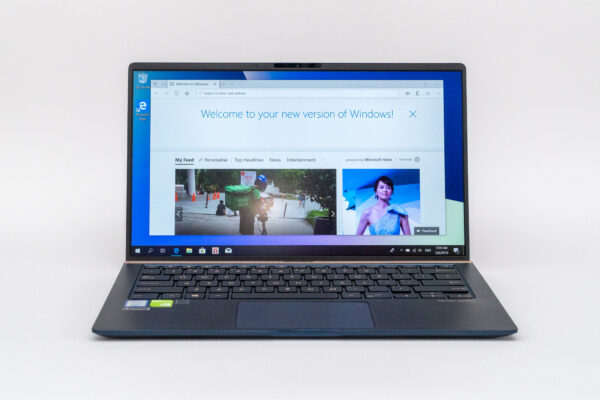
The new ZenBook 14 UX433F from ASUS is quite remarkable in many ways. For starters, this premium ultra-thin ultra-light notebook fits a 14-inch screen into a typical 13-inch notebook body, achieving a screen-to-body ratio of 92%. Then, there’s the build quality, performance, and yet more feature highlights to talk about.
The ZenBook 14’s diminutive size is quite amazing. Despite containing a 14-inch display, its dimensions stand at 319 x 199 x 15.9 mm, and weighs just 1.19 kg (1.09 kg with an anti-glare display). It’s both small and very light, and thus very easy to take around with you.
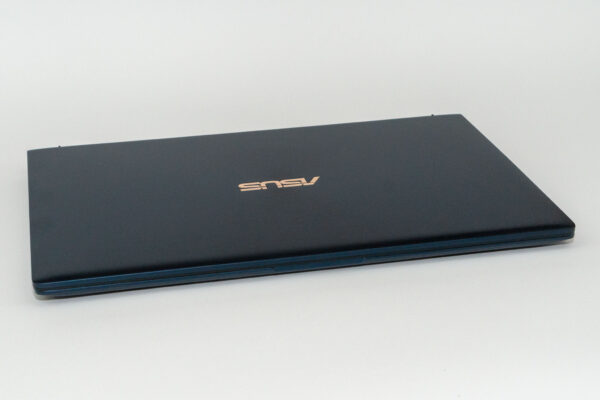
The concentric circle design with the centred ASUS logo on the lid immediately identifies this notebook as a ZenBook. That ASUS emblem on the lid, like on other ZenBooks in recent times, is emblazoned in gold. There is also the clever ErgoLift hinge seen in several recent ZenBooks, and a bit of gold accent at the back of the keyboard deck.
The overall build quality of the ZenBook 14 is excellent. In fact, ASUS says this robust aluminium notebook is tested to MIL-STD-810G military standards, which basically gives you the assurance that the ZenBook 14 is more ruggedly than your average notebook.
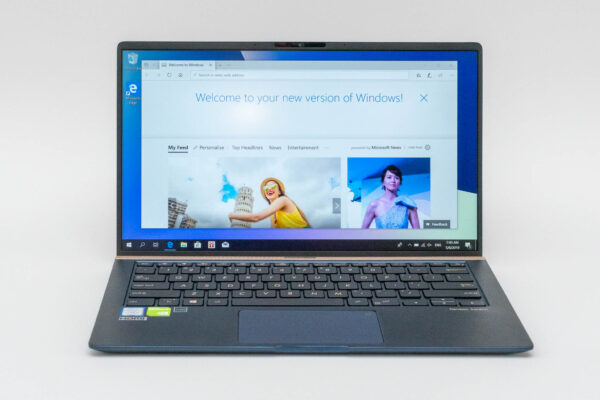
If you wanted to bring the all-screen smartphone design to notebooks, the ZenBook 14’s display would be it. This 14-inch display covers an astonishing 92% of the surface. The bezels around the screen are quite minimal. There’s a bit more bezel space at the bottom edge, but because of the ErgoLift design, most of it is obscured from view.
In these days when 4K displays on notebooks are quite common, the ZenBook 14’s Full HD 1920×1080 resolution display may not seem impressive. Unless you really need those extra pixels, Full HD is pretty alright in most casual use. The display offers 178° views. ASUS states 100% sRGB colour gamut, but my own tests with Spyder5PRO, I only managed to get 93% sRGB, with NTSC and AdobeRGB colour gamut coverage at 64% and 69% respectively.
From the side view, you can see how the ErgoLift hinge serves several purposes. First, it lifts the back of the ZenBook 14 to create a more room for improved airflow under the notebook. Next, lifting the back also creates an ergonomic gradient for more comfortable typing on the keyboard deck. Finally, the some of the bottom bezel gets hidden away, so you see more screen, and less of anything else.
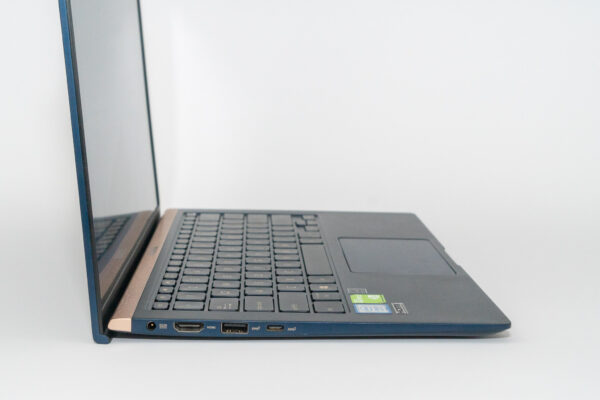
There is a decent selection of ports on the ZenBook 14. On the left side, you’ll find a USB 3.1 Gen 2 Type-C port, a USB 3.1 Gen 2 Type-A port, a HDMI port, and a power jack. I’m a bit disappointed that the ZenBook 14 doesn’t use USB Type-C to get its power. There is also no Thunderbolt 3 support.
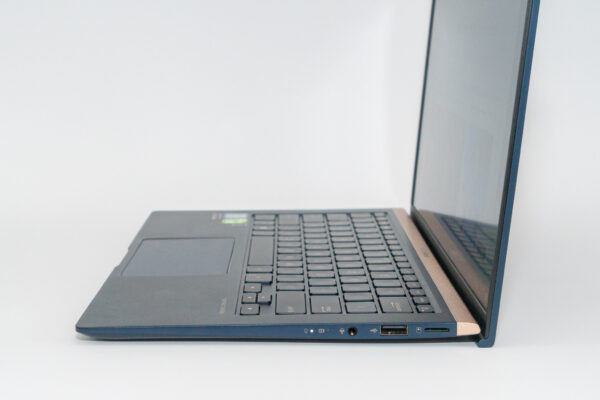
On the right side, you’ll find a 3.5 mm audio jack, a USB 2.0 Type-A port, and a microSD card reader.
The keyboard on the ZenBook 14 is comfotable and pleasant to type on. The keys are quite clicky, and they have a good 1.4 mm of key travel. I’m pleased to see a standard key layout, and the backlight helps with typing in the dark.
The touchpad works well. It uses Windows precision touchpad drivers, supporting up to four-finger gestures.
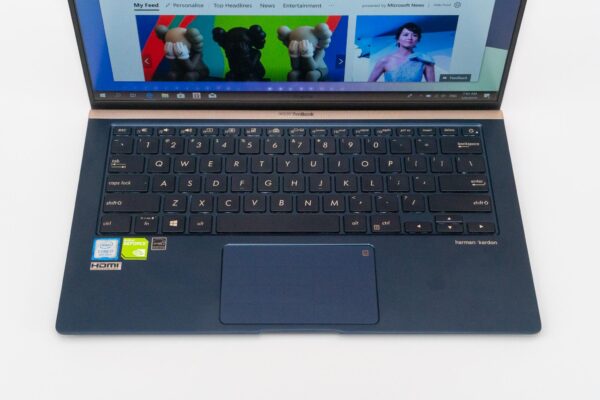
ASUS has a clever feature on the touchpad. As you see below, it can also double up as a number pad. Just touch the icon in the top right corer of the touchpad to illuminate the hidden markings of the number pad. You can now use the touchpad as a number pad by tapping on it. You can still slide your finger over the touchpad in this mode to move the cursor.
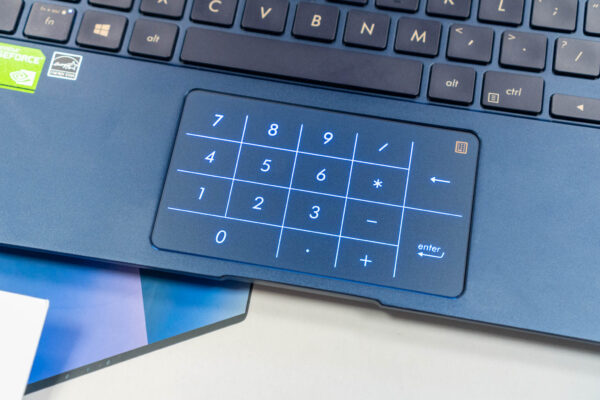
This sounds a little gimmicky. It probably is, for most people. However, for those who need to type lots of numbers, this number pad feature is definitely very useful.
Although the ZenBook 14 has no fingerprint reader, Windows Hello is supported using IR facial recognition with the webcam that is properly centred in the top bezel. This is quite remarkable considering the thinness of that bezel.
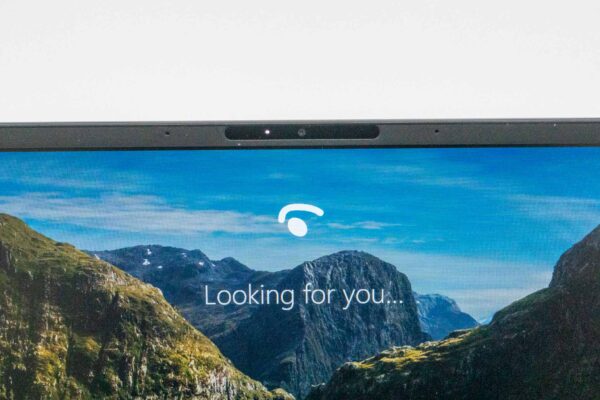
That tiny webcam still supports 720p resolution. It’s not great, but should suffice for the occasional Skype video calls. I’m just very happy to see ASUS managing to put the webcam where it ought to be, rather than moving it to other obscure location on the notebook.
There are also array microphones up there in the bezel, which work great with Cortana and Alexa.
The speakers are located along the front edge on the underside of the notebook. The Harman Kardon certified speakers produce quite powerful sound while sounding reasonably good for a notebook.
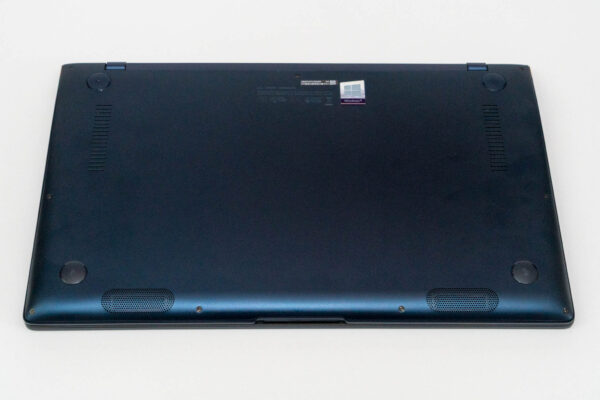
Under the hood, the ZenBook 14 is powered by an Intel Core i7-8565U with 16 GB of 2133 MHz LPDDR3 RAM. For storage, there is a 512 GB PCIe 3.0 x2 SSD. There is built-in NVIDIA GeForce MX150 dedicated graphics processor which, while not good enough for intense gaming, may provide some boost for graphic applications.
Testing with PCMark 10, I got the following scores:
- Overall: 3229
- Essentials: 6925
- Productivity: 6371
- Digital Content Creation: 3101
- Gaming: 2148
Geekbench 4 scores are:
- Single-Core: 5068
- Multi-Core: 14342
- Compute: 34876 (41590 with MX150)
The combination of newer 8th generation Core i7 processor and MX150 GPU gives this ZenBook 14 a bit of boost over regular notebooks.
The 50 Wh 3-cell lithium-polymer battery ran for a middling 3 hours and 24 minutes under the PCMark 8 Home Conventional battery test. Retesting at another time didn’t yield any notable difference. This is in the bottom third of all notebooks I’ve tested to date, and that would include power hungry gaming notebooks in the mix. A quick check on other reviews found that others did not find battery life as bad as I did mine. Your mileage may vary.
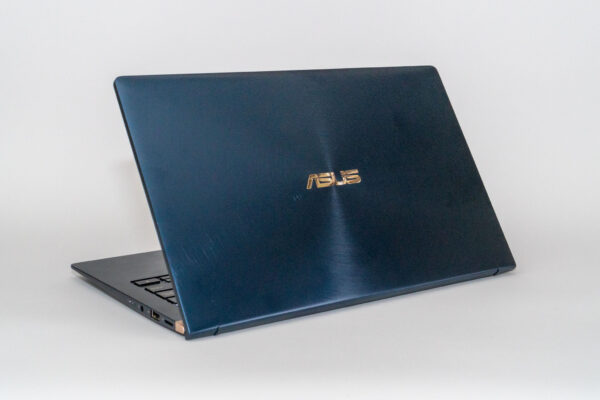
For connectivity, the ZenBook 14 boasts 2×2 MIMO 802.11 a/b/g/n/ac Wi-Fi with up to 1733 Mbps (theoretical) speed, and Bluetooth 5.0.
The ZenBook 14 UX433F is a beautiful, ultra-thin, ultra-light notebook that excels in many areas. The ErgoLift hinge has several practical benefits. The edge-to-edge screen is beautiful, The touchpad that doubles up as a number pad can be very useful to some users. Overall performance is great, thanks to newer 8th Generation Core i7 processor and the MX150 GPU. The notebook is also well-built and feels rather robust, with MIL-STD-810G to back it up.
However, there are two main issues I have with the ZenBook 14. I would love to have a touchscreen display. The biggest disappointment, to me, is the lack of USB Type-C power delivery. With many devices, both smartphones and notebooks, standardising on USB Type-C for power delivery, having to deal with a proprietary DC power barrel jack for the ZenBook 14 can be rather inconvenient.
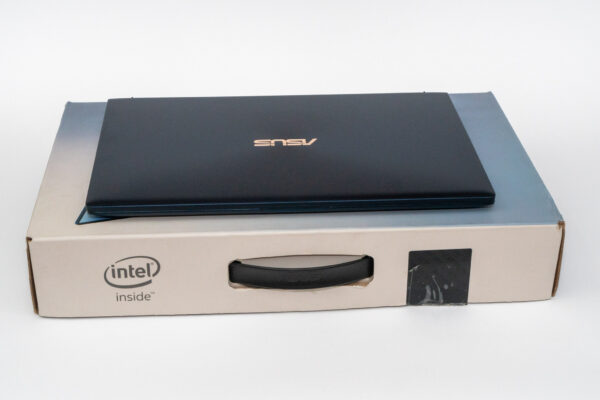
The ASUS ZenBook 14 UX433F as configured (16 GB RAM and 512 GB storage) retails at S$1898.
Conclusion
ASUS’ new ZenBook 14 UX433F is a beautiful, ultra-thin, ultra-light notebook with several cool features that help it stand out from other premium notebooks.
Pros:
- Ultra-thin, ultra-light, robust MIL-STD-810G construction
- Beautiful 14-inch display with minimal bezels
- ErgoLift hinge does quite a few useful things
- Touchpad that doubles up as a number pad
- Great overall performance
Cons:
- No USB Type-C power
- Not touchscreen
View Comment Policy